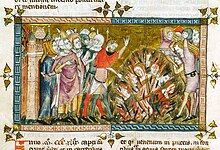Basel Massacre
A number of Jews, variously given as between 300 and 600 (according to contemporary Medieval chronicles) or 50 to 70 (according to some modern historians) were burned alive, after being locked in a wooden structure built on a nearby island in the Rhine.
[4] With the spread of the Black Death in the 14th century, there were pogroms against Jews triggered by rumours of well poisoning, which contributed to the anti-Semitic sentiment.
Although the rumors of well-poisoning certainly played a part in fueling anti-Semitic sentiment in Basel, "the immediate background to the persecution related to social and political problems";[4] some Basel nobles had indeed been temporarily banished from the city on the basis of what was believed to be false testimony provided by the Jews (Ac quibusdam eciam nobilibus Basilee pro quandam iniura Iudeis illata ad logum tempus bannitis).
[4] Already at Christmas 1348, before the plague had reached Basel, the Jewish cemetery was destroyed and a number of Jews fled the city.
[citation needed] A mob of members of the guilds burst into the Basel city hall, demanding that the exiled nobles be allowed to return.
Basel's massacre of Jews seems to have been premeditated, as suggested by the fact the mob was carrying banners, indicating that the action was thought up in advance.
Contemporary chronicler Matthias of Neuenburg describes the event with these words: “Therefore all the Jews of Basel, without a legal sentence [being passed] and because of the clamor of the people, were burned on an island in the Rhine River in a new house” (Cremati sunt igitur absque sentencia ad clamorem populi omnes Judei Basilienses in una insula Rheni in domo nova).
The officials of Basel placed judgement on some baptized Jews, and on 4 July four of them were tortured on the wheel, "confessing" that they had poisoned Basel's fountains (Juden ... Offenlich vor gerichte verjahen und seiten, das sie die brunnen ze unserre state etlich vergift hettent).
However, less than 15 years later, Jews were allowed back in the wake of the disastrous earthquake of 1356, as loans and funding were needed to rebuild the city.

